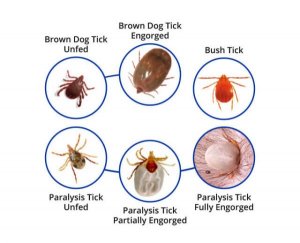With the onset of changing climate conditions, there are increasing concerns for how this may affect dogs’ health. Many people have asked, “Are ticks a problem for dogs in Melbourne?”

The Paralysis tick naturally occurs along the east coast of Australia with its southernmost limit being East Gippsland. But with increasing humidity and rising temperatures, from season to season, this range is expanding. Furthermore, with the removal of border restrictions between states, there is an increased potential for dogs to pick up ticks when being taken to other states.
There are 3 main dog ticks in Victoria:
- Brown Dog Tick
- Bush Tick
- Paralysis Tick – this tick causes the greatest concern for dog owners. It can be the most fatal for dogs out of all the ticks that are known to affect canines.
For regions that have had established tick populations the active seasons are typically between the months of September to April. Ticks hide in grasses and shrubs where they wait for a suitable host to brush past, and then latch on and crawl down to the skin.


Signs to look for –
Tick bite symptoms may include:
- Swelling/redness at the site of a tick bite
- Unstable hind legs or not able to get up – this is the most common symptom!
- A change in the sound of the bark or voice
- Retching, coughing (sometimes it is a moist cough), vomiting
- Excessive salivation/drooling
- Loss of appetite
- Difficulty breathing/grunting
Dog Health Check –
How to conduct a thorough body scan for ticks:
- Comb your fingers gently over your dog’s skin and fur.
- Pay close attention to armpits, ears and inside/at the corner of mouth.
- In almost 80% of cases of tick infestation, they will be found on the front half of the body – pay extra attention to scanning this area!
How to treat ticks –
- Keep your dog comfortable and calm in a resting position
- Remove any ticks on your dog’s body
- Take a photo of the tick in situ to show to your vet for identification
- If the tick’s head remains embedded in your dog’s skin do not apply any chemicals or substances to the bite zone.
- Consult your Veterinary doctor and have tested for the presence of toxins left over from the original tick bite.
Prevention is better than cure (of course), and your Vet can advise on a suitable prevention plan for your dog. Conducting a daily health check with your dog is also an effective way of ensuring they are not at risk of being infected by ticks. These checks are especially important after exploring bushland areas or sand dunes. At Dogdayz we complete daily health checks for all guests in our dog kennels – these are well received as additional personal cuddle time too!
You can learn more about ticks, treatment and affected regions in these articles from NexGard (Tick Check | NexGard) and RSPCA Vic (Flea and tick prevention).

